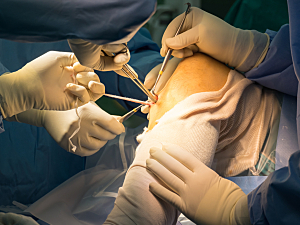About half of patients who had anterior cruciate ligament reconstruction (ACLR) develop posttraumatic knee osteoarthritis within 15 years, which has partly been attributed to altered knee biomechanics.
Christian Lattermann, MD, Mass General Brigham director of Sports Medicine Research, director of the Cartilage Repair Center at Brigham and Women’s Hospital and chief of the Division of Sports Medicine, Alexa K. Johnson, PhD, of the School of Kinesiology at the University of Michigan, and colleagues recently conducted a pilot study of what factors contribute to altered loading. In Sports Health, they report that pain one month after surgery and change in pain scores were significantly associated with running mechanics six months after surgery. In addition, the underloading was evident in the affected limb and overloading in the uninvolved limb, indicating a greater need for running rehabilitation after ACL reconstruction.
Methods
The pilot study was a secondary analysis of a double-blind, randomized, controlled trial that was itself a pilot study (published in Medicine & Science in Sports & Exercise). 24 patients, ages 14 to 33, who suffered an ACL injury during sport were randomly assigned to have intraarticular hyaluronic acid or placebo administered one week after surgery. (No treatment effect of hyaluronic acid was observed.)
The patients were prescribed a standard rehabilitation protocol. One month after surgery, they completed a visual analog scale (VAS) for knee pain and the Knee Injury and Osteoarthritis Outcomes Score (KOOS) questionnaire, yielding scores for each of the five sections: knee symptoms, pain, quality of life, activities of daily living (ADL), and sport and recreation.
Six months after surgery, 20 study participants and 20 control subjects underwent a biomechanical analysis of overground running using 3D motion capture and force plates.
Links Between Patient-reported Outcomes and Biomechanics
Peak knee abduction moments in the affected limb during the running analysis were associated with the following measures at one month:
- KOOS pain scores (R2, 0.35; β, 0.07; P=0.01)
- KOOS sport and recreation scores (R2, 0.23; β, 0.007; P=0.05)
- Change in VAS pain score from month 1 to month 6 (R2, 0.55; β, 0.01; P=0.001)
Limb Differences During Running
During the stance phase of running, there was:
Injured limb vs. uninvolved contralateral limb
- Less knee excursion (P=0.0001)
- Smaller knee extension movements (KEM) (P=0.0001)
- Lower vertical ground-reaction forces (VGRF) (P=0.0001)
Injured limb vs. a control limb
- Less knee excursion (P=0.0001)
- Lower KEM (P=0.003)
- Lower VGRF (P=0.005)
Uninvolved limb vs. a control limb
- Greater VGRF (P=0.002)
Implications for Rehabilitation
These results suggest that patient-reported outcomes one and six months after surgery are associated with running mechanics six months after ACLR. A continued underloading present in the ACLR limb and overloading in the uninvolved limb indicates greater need for running rehabilitation after ACLR.
It will be important to identify patients who are continuing to underload the involved limb and overload the opposite limb in order to restore equal loading conditions.
It will be important to find ways to identify patients at higher risk early in the rehabilitation timeline and target therapies to lessen the amount of time a person spends with poor loading patterns.
